Can a week have passed since last we met in Hemel Hempstead ? And should I admit I still have not put my gum cards in the plastic leaves I bought there ? But I have had other things on my mind - and as I said at the Annual General Meeting, whatever else is going wrong in my life, sitting here, tapping away, and researching, does a really good job of stopping those other things coming in and depressing me.
So on with this week, where we have a sporting struggle, a bloody battle, an eager audience, a Royal residence, a Chatham creation, a legal language, and a poet`s place. (Those came relatively easy, sometimes it is late and I just cannot think of one)
Let us start then, with that sporting struggle ... and also, note to self, do press "save" as you go along...
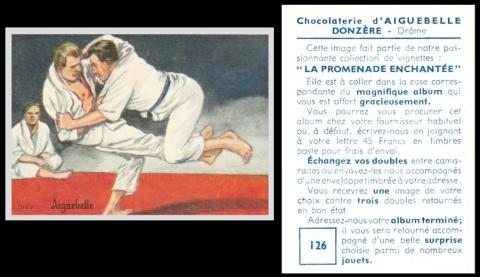
Chocolaterie d`Aiguebelle [trade : chocolate : O/S - Drome, France] "La Promenade Enchantee" / "The Magic Parade" (1959) 126/144
I found this quite odd, but it was only in 1956 that the first judo world championships were held. Though when I first wrote it down I wrote 1856. Subsequent research has revealed that this earlier date was just a bit too early, for judo, or more correctly Kodokan Judo, was a Japanese development of Jiu-Jitsu, a Samurai way of training, which was created by Jigoro Kano in 1882.
It follows the same basic idea as Jiu-Jitsu, still emphasising the fact that you do not have to be larger than your opponent, you just need to use their size and strength against them.
Another thing I discovered was that it first appeared in the Olympics in 1964.
So, to the 1956 World Judo Championships, which were held in Tokyo, Japan, in May 1956, and attracted thirty-one competitors, all men, from twenty-one nations. It was run as an open competition, irrespective of weight.
The winner, Shokichi Natsui, and the runner up, Yoshihiko Yoshimatsu, were both Japanese, but the bronze medal was shared (or maybe they got one each) by Henri Courtine of France and Anton Geesink of the Netherlands.
There was also a British competitor, Richard Bowen, who is a very interesting character, he was born in Belgravia, London, in 1926, and at the age of twenty three he suddenly became very interested in judo, so much so that he joined a club and was selected to compete at the Olympic Games. After that he moved to Japan and did three years of additional training.
Jiu-Jitsu appears on several early sets, by W.D. & H. O. Wills ("Jiu Jitsu", issued in 1910, overseas, with `Flag` and with `Scissors` brands) and by John Player ("Wrestling and Ju-Jitsu", issued in 1913).
Judo is not on many, and this could well be the first - the only other ones I have come across are Sweetule`s "Sports Quiz" (No.13 - 1958) and Dickson Orde`s "Sports of the Countries" (No.17 - 1962). But maybe you know of others?
By the way, the question on the back of the Sweetule card is "Judo is a very special type of wrestling. It comes from a far eastern country. Do you know the name of the country of origin? For answer see card no.14" - I don`t have that card, but I am guessing it says "Japan".
Whereas the back of the Dickson Orde set tells us that "The Japanese are very skilful wrestlers and there are several kinds of wrestling. The picture here shows a pair of Judo wrestlers demonstrating the "Tomoen-age" or Stomach Throw. The more usual sports of international character are also played."
This card was issued by Aiguebelle, and was intended to go in an album called "La Promenade Enchantee" - this translates to "The Enchanted Walk", which makes very little sense. I think it ought to be something along the lines of "The Magic Parade", in other words a procession of different cards, to delight and inspire. These are split into sections, which you can read about at the Football Cartophilic Exchange / Aiguebelle LPE. They also show the album.
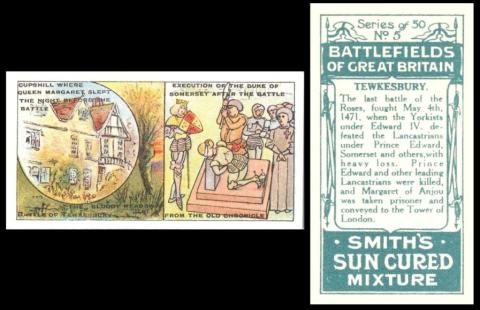
F. & J. Smith [tobacco : UK]”Battlefields of Great Britain” - `Sun Cured` brand (1913) 5/50 - S548-050.N : S84-2.N
Today will hopefully be a peaceful day, but in 1471 the Wars of the Roses met their grisly end, at the Battle of Tewkesbury, in Gloucestershire, as demonstrated on this card, and the House of York, led by King Edward IV and his troops, finally vanquished the House of Lancaster, killing their heir to the throne, Edward Prince of Wales, along with many of his forces.
At the same time, the current King, Henry VI, also of the House of Lancaster, who was at that time, mouldering away in the Tower of London, also died, which does seem rather too much of a coincidence for such to have been from natural causes.
Now there is a bit of a discovery with this card, for I think I have found what may be the original picture from which the beheading scene on it was taken, that is from a manuscript, currently held by the Ghent University Library, titled "Histoire de la Rentrée Victorieuse du Roi Edouard IV and Son, Royaume d'Angleterre, 1471", and it tells the story of how King Edward IV went from Bruges, invaded England, and beat Henry VI at Tewkesbury, kind of what we today know as a "highlights reel", but it is recorded to have been drawn from eyewitness accounts, which is why I am presuming it is the origin, and there is none earlier.
I base this on the slightly skewed, almost diagonal shape of the plinth, the portliness of the executioner, and the figure not quite wanting to look to the executioner`s right, so is facing the group at the edge of the image. The figure on the executioner`s left is also in our image, but he has no other sidemen. The background is also missing.
We have featured this set several times, but our aim is to be able to show you all the possible backs, as this card is actually available with fifteen brands - hence we have a home page, which is with our Card of the Day for the 20th of March, 2024. There you will also find links to see the other backs, and a biography of the issuer.
As far as "Sun-Cured Mixture" it certainly conjures up a summery image, and also, perhaps, thoughts of emigration. But I have not yet found a tin or packet to show you....
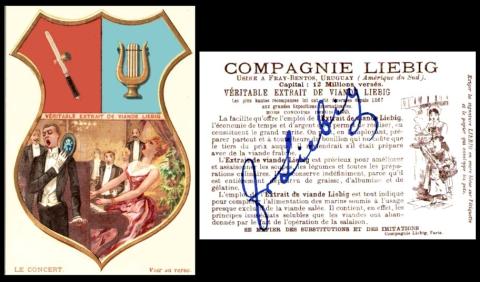
Liebig [trade : meat extract : O/S - South America] "Armoires" / "Stemmi" / "Coats of Arms" (1891) Un/6 - F.0328 : S.0326
Today is #NationalConcertDay, which hopefully may mean that one is on the horizon for me to attend, I have checked a certain website every night for getting on for a year, without any sharp intake of breath and pounding pulse - for it was in June last year that I last travelled into town for that purpose.
I wonder why concerts are so popular, and what we really gain from them? I think it is the camaraderie, the singing along with fellow fans, and the sheer joy of being able to, without being told to shut up. The freedom. And also, perhaps, a chance to meet your favourite singer or band, if you are lucky, or prepared to pay extra for the privilege.
There are lots of cards of concerts, but this one captures that joy so well, and it is by Liebig, an issuer whom I do not really associate with great humour.
I have also had a bit of a discovery about this set, for the title most usually given is rather boring, simply "Armoiries", or, in some cases, a longer form, of "Armoiries, Blasons, Metiers", which translates to "Coats of Arms, Blazons, Trades". However, the cards are not titled, and I have unearthed the fact that in Italy this set is known colloquially as "Stemmi", which is an Italian term for symbols used to represent families or organizations, especially objects which are not so serious as the official ones. And I think that is definitely true of our set, which comprises :
- L`Avocat (the judge - a parrot and a bottle of drink)
- Le Concert (the singer - a baton and a tuning fork)
- Le Jeu (the gambler - snooker cues and balls, and playing cards and dominoes)
- Le Journaliste (the journalist - a quill and two swords, crossed, and a flying duck)
- Le Medecin (the doctor - saws and a knife, and bottles of drink)
- Le Peintre (the artist - a pipe and a bag of tobacco, and a bottle and glasses - which says Absinthe)
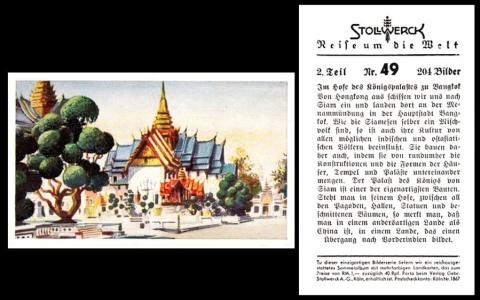
Stollwerck [trade : chocolate : O/S - Germany] "Reise um die Welt" / "A Voyage Round the World" - second series (1930s) 49/204
To another world now, for today in 1782 saw the start of construction of this building, the Supreme Grand Palace in Bangkok.
As to why it is there, it is because in 1782 the King of that time, Rama I, ordered that to mark the start of his new dynasty, the Chakri, there must be a new capital city, so it moved from Thonburi to Bangkok.
Building of the palace started almost immediately, though the name "palace" is a bit of a misnomer, for it is not one building, it is a selection of different buildings, each with a set purpose, temples, halls, pavilions, large and small.
The most famous building is the Temple of the Emerald Buddha, which started to be built in 1783, and is now the most sacred Buddhist temple in Thailand. It took two years to be ready enough to receive the Buddha statue, which had formerly lived at the old palace in Thonburi.
It is still called the Palace, but the Kings do not live there any more, it is more of a tourist attraction, until it is required for a state event. However, at the time this card was circulated it was indeed their home, and that was so until 1925.
Then in 1932, absolute monarchy was abolished, and the palace was left.
This card is not the one we started with, as when I got to here and went to add the picture I discovered I had already used that set, it was Guerin Boutron`s "Tour de Monde", so now we have a Stollwerck card, or we will if I can manage to do it. This is a later card than the ones we usually feature and it has a definite foreboding about the typeface that makes me think 1930s.
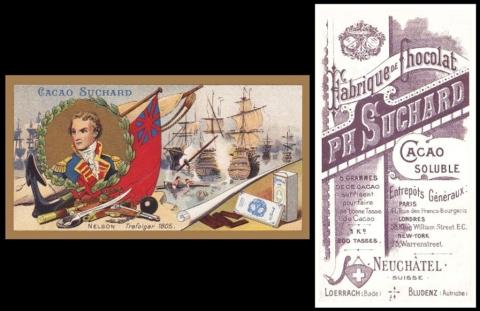
Suchard [trade : chocolate : O/S - Neuchatel, Switzerland] "Hommes des Guerre Celebres" / "Famous Men of War" - Series 59 (19)
Onwards and upwards and off to sea, for today in 1765 saw the launch of H.M.S Victory. By all reports this was a grand affair, with several former Lords of the Admiralty in attendance.
However the ship had been a long time building. The order for her construction had been signed in July 1759, and work had begun almost immediately, then stopped. There were two reasons for this, the first was that ships needed to dry out naturally, and so they were built, then left in a frame so that the timber shrank and made her water tight. But the second was a bit more interesting, as that was the Seven Years War, a world war of sorts, and involving most of Europe. That was fought from 1756 to 1763, hence its name.
We do not know why the Victory was not tested there, nor why she was not originally fitted out as the flagship which we know her as today, only as befitted a ship of the reserve fleet. But then suddenly she turns up as a flagship, under Captain the Honourable Augustus Keppel, commanding the Channel Fleet, and, in July 1778, leading it to victory against the French off Ushant, as well as distinguishing herself in the Battle of Cape St. Vincent in 1797.
By that time she was almost forty years old, and had been through wars and all manner of weather. In fact it was thought that she was sailing back to England to be scrapped, but she was saved, by a total refit, and almost a rebuild, it certainly cost almost as much as her original building had cost. And somehow, she found herself being given to Admiral Lord Nelson, as his flagship, to sail the Mediterranean, and to fight again at the Battle of Trafalgar, on the 21st October 1805.
This card is by Suchard, and many thanks to Mr. Price who told me that I was not too far out with my thought of "Famous Battles", but that it is actually known as "Hommes des Guerre Celebres" or "Famous Men of War" - and it is Series 59.
And he also gave us this list of the cards in the set are :
- Abd. El Kader 1807-1883 / Algerie 1840
- Archiduc Charles / Essling 1809
- Arnold de Winkelried/ Sempach 1386
- Frederic Le Grand 1712-1786 / Parade 1760
- Kleber 1753-1800 / Heliopolis 1800 / Plewna 1877
- Marechal Ney 1769-1815 / Moskowa 1812
- Napoleon I / Austerlitz 1805
- Nelson / Trafalgar 1805
- Skobeleff
- Souvaroff 1729-1800 / Foleschani 1789
- Wellington 1769-1852 / Waterloo 1815
- Von Moltke 1798 - Metz 1870
The only thing we still do not know is the date of issue.....
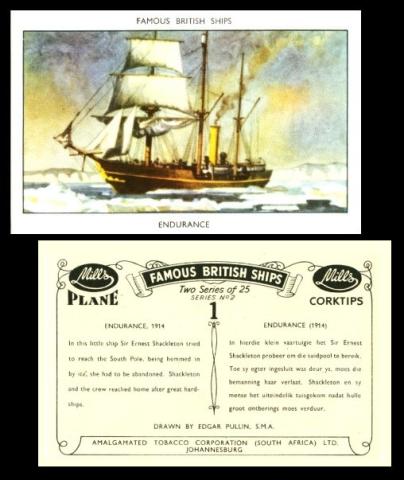
Amalgamated Tobacco Corporation (South Africa) Ltd [tobacco : O/S - Johannesburg, South Africa] "Famous British Ships" - second series (19) 2/25
This card is not only important because it gives us series two to add to our series one - our Card of the Day for the 25th of September 2024 - but it is bi-lingual, in English and Afrikaans. And today, in 1925, a hundred years ago, Afrikaans was made one of two official languages of South Africa.
Now Afrikaans is not a native language, it is most often said to have been originally developed from Dutch, but it is actually rooted in Germanic. It is mainly spoken in the home of this card, South Africa, with some crossing into Namibia, especially where it joins to South Africa, and it seems to have come to Africa at the time that Dutch settlers were landing at the Cape Colony.
It has changed, a lot since then, and there are various dialects. Some of this is due to there not being words in their own language for some of the things so prevalent in Africa, but there has also been some colloquialisms and shortening of words, and also a great deal of modernising, as time has gone by. There were also two distinct forms, the one used by the masters, and the one used by the staff, and the slaves, both of the latter being designed so they could talk freely amongst themselves and not face punishment for their hopes and dreams.
Then, today, in 1925, all that changed, as the South African government recognised Afrikaans as a distinct language, not just an offshoot of Dutch. The statute was the Official Languages of the Union Act, 1925, and that was passed almost entirely due to pressure from the Afrikaans Language Movement.
Then, thrillingly, in 1961, Dutch was phased out as an official language, becoming classified as a branch of Afrikaans. And just two years later, any reference to Dutch was removed from the papers
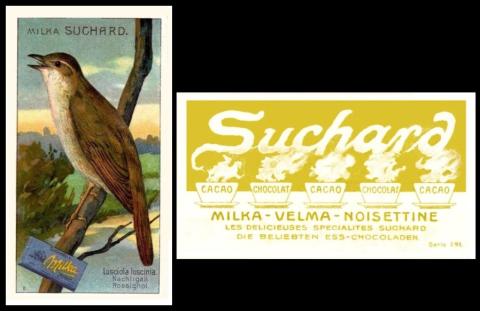
Suchard [trade : chocolate : O/S - Neuchatel, Switzerland] "Birds"? Serie.291 (19) 8/12
Another centenary, to close with for this week, and that is of the date that Keats` House, in Hampstead, was opened to the public.
We ran out of time to look longer for cards of John Keats that were in sets we had not used before, and so we have this, the nightingale, who he immortalised in one of his most famous works, "Ode to a Nightingale", written in 1819. However it is also here because whilst that poem was either written at the Spaniards Inn, or beneath a plum tree in the garden of that very house, the nightingale was nesting in a hedge near enough to the house to have become a regular visitor to the garden.
It is, in many ways, an odd and wistful poem. There is a man, who hears a soft and lilting song sung by a bird, and he wonders what it would be like to change places, to just sit and sing whenever he feels like it, to never worry about illness or death. It is strange in that, because all creatures get sick and die, and they do experience the same emotions and fears as us, but we do not know of their death, unless they are our household pets of course, and we hear the same song in a following year and imagine it to be the same bird, everlasting.
In fact John Keats died two years after the poem was published, so it is very possible that his nightingale did outlive him, for their lifespan is from one to eight years - though the average is only two years.
This set is quite scarce, and I have a feeling that the title may be `Garden Birds`, for the subjects I know so far are :
- Blackbird
- Bullfinch
- Long Tailed Tit
- Great Tit
- Warbler
- Lark
- Robin
This week's Cards of the Day...
This week we are going to again join Royal Mail, whose new commemorative stamps will be released on the first of May, and are entitled Valour and Victory: Stories of the Second World War. They concentrate on heroes who are not necessarily military personnel, and I will tell you about them as we go through the week
Our cards were :
Saturday, 26th April 2025
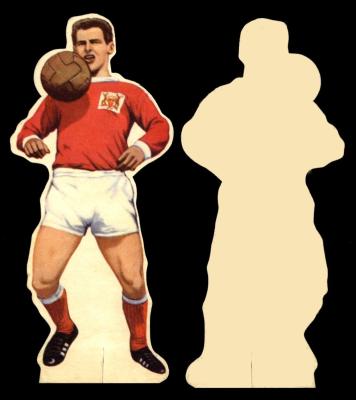
... this was chosen because these items were issued with the magazine "Victor", though it does not say so anywhere on them, only on the sheets from which they were pressed or cut out, and in most cases those have long since been discarded.
Here we have one of the more active cards from this set, some are simply footballers standing still.
Our man is Colin Addison, and he was born on the eighteenth of May, 1940, in Taunton, Somerset. However the fact that he signed for York City makes me think that his family had relocated to Taunton temporarily at the start of the Second World War, thinking York was a bigger target, or his father had been stationed down there and the family had got lodgings nearby. I will try to find out.
Anyway he was with York City for four years, from 1957, when he was seventeen, to 1961. He then moved about a bit, and in the next twelve years he had stints at Nottingham Forest, Arsenal. Sheffield United and Hereford United, who he also managed at the same time as playing. After he left them he went into managing solely, all around the globe.

Now it was not until I was sent the missing link that I found the cards in our British Trade Index part two, because the line at the feet of Mr. Addison is not very thick. But now i have the missing link I can see that you insert the semi circle up the small line and you get a cross shape on which your footballer stands up on your desk etc (albeit very briefly, if you have a dog, or small child, or even a gust of wind).
Once I saw this I found the set quickly, and it is catalogued as :
- FOOTBALLERS - TO STAND UP (A). Issued in sheets, models about 90 x 100 m/m/ high when cut from sheet. Unnd. ... THO-208
1. Issued January, 1965. Inscribed "The Victor". 3 sheets :-
1. John Sjoberg, Cliff jones, Bobby Moore, Len Allchurch, Jim Baxter, Brian Miller, Fred Pickering, Colin Addison
2. Denis Law, Johnny Haynes, Charlie Aitken, Alec Hamilton, Norbert Lawton, Mel Nurse, Ronnie Clayton, Terry Paine
3. Gordon Milne, Jimmy McIlroy, Dave Holt, Jimmy Armfield.
2. Issued October, 1965. Inscribed "Hotspur". 2 sheets :-
1. Alan Suddick, Alan Sealey, Jacky McInally, Billy McNeil, Joe Kiernan
2. Chris Lawler, Barry Bridges, Jackie Charlton, George Best, John Greig
3. Issued February, 1968. Inscribed "The Victor". 2 sheets :-
1. Clive Clark, George Mulhall, Mike England, Tony Hately, Nobby Stiles, John Giles, John Clark, Martin Peters, Peter Osgood
2. George Eastham, Alan Ball, Joe Baker, Pat Stanton, George Cohen, David Ford, Willie Henderson, Terry Neill, Dave Gibson
This is unaltered until our British Trade Index part three, and that is only to adjust the size, simply reading :
- THO-208 (Footballers - To Stand Up). Correct size of models to 100 x 30 m/m
However in our updated British Trade Index the ones by "The Victor" and the ones by "Hotspur" are suddenly split, so this listing reads :
- FOOTBALLERS - TO STAND UP (A) (H)(V). Shaped, about 100 x 30. Issued in cardboard sheets. Unnd. See HT-44 ... THO-360
1. (V) 1965, January. Unnd (3). 2. (H). 1965, October. Unnd (2). 3. (V) 1968. Unnd. (2)
- FOOTBALLERS - TO STAND UP (A) (VC). About 75-80 x 20-35. Unnd. (12) Press-outs to stand up. Issued as one sheet. See HT-45 ... THO-365
The problem with this is that the abbreviations are quoted in the header as (V) for "Vanguard", and (VC) being for "The Victor"
The HT codes are in the updated British Trade Index Handbook and that is not with me. I am at the bottom of the garden.
Sunday, 27th April 2025

Here we have the other word in the title of the stamps, "Valour". Now that means bravery, or courage, especially in the face of a foe at war, but it actually comes down from the Vikings, for in ancient Norse it means "the dead". It also means "a place where dead lie", though, most usually a battlefield, and from that it was slightly adjusted to mean the people who had fought with glory, but not survived.
This is a very unusual medal, and yes, it was named after Prince Albert, the husband of Queen Victoria. It began in 1866, five years after his death, as a medal with a blue background, as we show here, simply because it was to be given for people who saved lives at sea. There were two classes, the first, in gold, and the second, in bronze. But most importantly it was not a medal for soldiers and sailors, it was an award for civilian gallantry. And the first recipient was a farmer, Samuel Popplestone, who helped rescue four men off a cargo ship which had been swept on to rocks in a massive gale.
In 1877 the medal was also made available with a red background for saving lives on the land, and that also came because of a single event, the Tynewydd colliery disaster. And it was first given to a physician. It also came in first and second class forms.
In 1917 the name was slightly changed, to become the "Albert Medal in Gold" (the former first class), and the "Albert Medal" (the former second class). This remained through the Second World War up until 1949, when the "Albert Medal in Gold" was removed from the medal roll and replaced by the George Cross, though the former second class "Albert Medal" was still given, posthumously. Then, in 1971, it gets even more confusing, because living recipients were given a chance to exchange their Albert Medals for George Crosses. I have also been unable to find how many were awarded during the Second World War but one day I will add that too.
This set is catalogued in our original British Trade Index part two, as :
- BRITISH ORDERS OF CHIVALRY & VALOUR. Sm. 60 x 31. Nd. (25). Back in (a) black (b) blue ... CLZ-2
And this remains virtually the same in our updated British Trade Index, as
- BRITISH ORDERS OF CHIVALRY & VALOUR. 1957. 60 x 31. Nd. (25). Back in (a) black (b) blue ... CLE-090
Monday, 28th April 2025
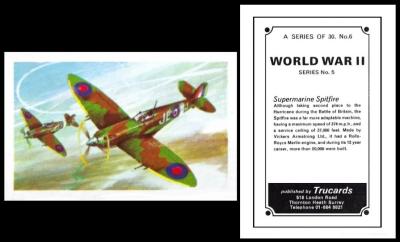
Our card today was selected simply for the time frame. World War Two, however it also represents the entire air force and the civilian workers, whose place of employment was not only a huge target, but they were often caught up in the chaos when a landing or take off went awry. And most of all it celebrates two of those commemorated on the new stamp issue -
- Squadron Leader Mohinder Singh Pujji DFC, born on the 14th of August, 1918, in Simla, India, one of the first Sikhs to volunteer, who flew primarily Hurricanes but also Spitfires for the Royal Air Force and the Royal Indian Air Force between 1940 and 1946. However, before the war he was a pilot with Himalayan Airways. He died aged 92, in Kent. He is shown wearing his Sikh headwear, which he wore throughout his flying career, despite the fact that it prevented him wearing his oxygen mask, and that would later lead to lung damage. He died, of a stroke, aged ninety-two.
- Lilian Bader was born Lilian Bailey on the 18th of February 1918, in Toxteth, Liverpool, England. Her father was from Barbados, and he was a merchant seaman. Her mother was Irish. Their father died when she was just nine, and she was put in a convent. It is not clear whether she ever saw her two brothers again. She enlisted right at the start of the Second World War, but faced prejudice from the authorities, and was dismissed. It took her until 1941 to join up again, in the Women`s Auxiliary Air Force. Though they were not allowed to fly Spitfires, they were charged with maintaining them. They were also, oddly, allowed to train new pilots, before they went in the air. Miss Bailey was also trained in instrument repair, becoming a Leading Aircraftwoman, and then a Corporal. She also got married, in 1943, to Mr. Ramsay Bader, who was a tank driver in the Royal Artillery. She had her first child in February 1944. and two subsequently. She died at the age of ninety-seven.
This set, and all the Trucards issues, appear in our original British Trade Index volume III, and we do have a homepage for this issuer, with our Card of the Day for the 28th of June 2023 - where all the other sets are listed, with links out and in to see them.
The full listing of this set reads :
TRUCARDS, Thornton Heath, Surrey.
Cards Issued 1972
- World War II. 69 x 45. “Series No.5”. Nd. (30) ... TRWM-8
Now sadly this issuer does not appear in the updated British Trade Index, because the cards are commercial. That was one of the (sadly necessary) exclusions that was decided to keep the book small enough to handle.
Tuesday, 29th April 2025
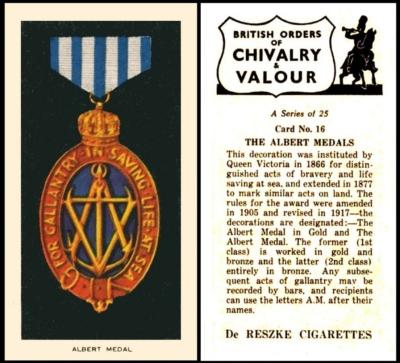
This is a readers card, who noticed the similarity between it and the card by Clevedon Confectionery that we featured on Sunday.
The text on today`s card and Sunday`s is almost identical, but parts have been excised. The top is entirely the same, word for word, right until you get down to "The Albert Medal in Gold and The Albert Medal". Then Sunday`s card just closes with "The former 1st class and the latter 2nd Class", whereas ours closes with "The former (Ist class) is worked in gold and bronze and the latter (2nd class) entirely in bronze. Any subsequent acts of gallantry may be recorded by bars, and recipients can use the letters A.M. after their name.". So did Clevedon copy their words off the back of the older sets, and when they ran out of space (because they used a horizontal format) just condense what was left?
I was just going to add this scan as part of the listing for the Clevedon set, but when I started looking it up I found it to be a very tangled tale, as our version is branded for De Reszke, and that is a brand by Millhoff. However you will not find it under their name in our original World Tobacco Issues Index, because, as the listing for Millhoff in there tells us, "For brand issues inscribed "De Reszke Cigarettes" and cards inscribed with both Millhoff and Phillips names, see under Godfrey Phillips."
So I then returned to the library, and found our original Godfrey Phillips reference book, (RB.13, issued in 1949), where their version of this set is described as :
- 43. 25. BRITISH ORDERS OF CHIVALRY AND VALOUR. Small cards, size 67 x 37 m/m. Fronts printed by letterpress, order in colour on black background. Backs in sepia, with descriptive text. Issued in export brands , 1939. Similar series issued by United Kingdom Tobacco Co.
Strangely, you may think, there is no mention of Millhoff. This is even stranger when you discover that in the 1950 London Cigarette Card Catalogue the set was not listed under Millhoff, instead it is under Godfrey Phillips, recorded as :
- 25. BRITISH ORDERS OF CHIVALRY AND VALOUR. (1939). Ha.599
A. Back "Godfrey Phillips Ltd., and Associated Companies"
B. Back "De Reszke Cigarettes" (no maker`s name)
No prices appear for either of these versions, which only means they had insufficient stock at that present time to allow for mass orders. They did, however, offer the United Kingdom Tobacco version, as :
- 25. BRITISH ORDERS OF CHIVALRY AND VALOUR. (Nov.1936) - "The Grey`s Cigarettes"
Ha.599 odds sets
2d. * 4/6
The asterisk tells us that "Special offers of sets of these series appear in our Abridged Catalogue" (and I bought the 1939 one of those at the Convention this weekend....)
The entry Ha.599 takes us to the original London Cigarette Card Handbook, where the entry is :
- Ha.599 BRITISH ORDERS OF CHIVALRY AND VALOUR. (titled series) Front in colour. Numbered series of 25.
Phillips - A. Back "Godfrey Phillips Ltd., and Associated Companies"
B. Back "De Reszke Cigarettes" (no maker`s name)
United Kingdom Tobacco Co. - Back "The Greys Cigarettes" without maker`s name.
Anyway, back to our original World Tobacco Issues Index, and to Godfrey Phillips, where their entry reads
- BRITISH ORDERS OF CHIVALRY AND VALOUR. Sm. Nd. (25). See Ha.599 ... P50-98
This text is repeated under the listing for United Kingdom Tobacco Co., where it is catalogued with the issues circulated with "The Greys" brand, the only difference is the card code, of U10-8. If you look at those cards, they are identical on the reverse, the same shield with the set title, and bugler on galloping horse, but at the bottom the inscription reads : "THE "GREYS" CIGARETTES"
Oddly, in our updated World Tobacco Issues Index, these are listed under Millhoff, in section 1.C, for "The DeReszke brand issues. Cards inscribed "De Reszke Cigarettes", or "De Reszke Minors Cigarettes" without name of firm. Period 1934-39", and catalogued as :
- BRITISH ORDERS OF CHIVALRY AND VALOUR. Sm. Nd. (25). See RB.113/43 ...M699-420
The Phillips version reads the same as this, but the card code is P521-424. However, the United Kingdom version is altered, to read
- BRITISH ORDERS OF CHIVALRY AND VALOUR. Sm. Nd. (25). See RB.113/43 ... U450-520
A. On creamish board, type-faces as Set P521-424, "A Series of 25" measuring 13 m/m.
B. On brownish board, type-faces changed, "A Series of 25" measuring 12 m/m.
The cards in the various series are as follows. At the moment there are abbreviations, but only whilst I hunt through for the missing cards, namely
- (M) Millhoff
- (P) Phillips
- (U) United Kingdom
- (C) Clevedon
- Victoria Cross (M)(P)(U)
- The Most Noble Order of the Garter (M)(P)(U)
- The Most Noble and Most Ancient Order of the Thistle (M)(P)(U)
- The Most Illustrious Order of St Patrick (M)(P)(U)
- The Most Honourable Order of the Bath (M)(P)(U)
- Order of Merit (M)(P)(U)
- Most Exalted Order of the Star of India (M)(P)(U)
- The Most Distinguished Order of St Michael & St George (M)(P)(U)
- The Most Eminent Order of the Indian Empire (M)(P)(U)
- The Royal Victorian Order (M)(P)(U)
- Order of the British Empire (M)(P)(U)
- The Order of the Companions of Honour (M)(P)(U)
- Distinguished Service Order (M)(P)(U)
- Imperial Service Order (M)(P)(U)
- The Order of St John of Jerusalem in England (M)(P)(U)
- The Albert Medal (M)(P)(U)
- Distinguished Service Cross (M)(P)(U)
- Conspicuous Gallantry Medal (M)(P)(U)
- Distinguished Service Medal (M)(P)(U)
- Military Cross (M)(P)(U)
- Distinguished Conduct Medal (M)(P)(U)
- Military Medal (M)(P)(U)
- Distinguished Flying Cross (M)(P)(U)
- Air Force Cross (M)(P)(U)
- Distinguished Flying Medal (M)(P)(U)
Wednesday, 30th April 2025
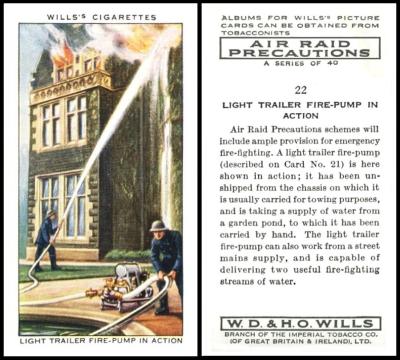
This card celebrates George Arthur Roberts, BEM, MSM, who was a firefighter, and is commemorated on one of the new first class stamps.
He was born in Trinidad in August 1891, and so was forty-seven when the Second World War broke out. He had already served in the First World War, starting in the Trinidad Army, and working his way across from there to England, where he joined the Middlesex Regiment, as a rifleman. He was wounded several times, including at the Battle of the Somme, but gained a reputation for accurate bombing, being able to throw grenades right back into the enemy lines.
When the Second World War arrived, he was classed as too old, the government only accepted men aged between eighteen and forty-one. However, they soon realised that this exempted many men and women with military training, and so these were re-interviewed to form the Home Guard and other quasi-military posts. One of these branches was the fire brigade, which gained a new sub-group called AFS, or the Auxiliary Fire Service. Mr. Roberts was sent to New Cross Fire Station, where he was an invaluable member of the squad, so much so that he was awarded the British Empire Medal in 1944, "for general duties at New Cross Fire Station, and for his part as a founder and pioneer of the discussion and education groups of the Fire Service."
After the war he was a passionate advocate for inclusion, and also founded a branch of the British Legion near where he lived.
He died on the 8th of January, 1970, and is commemorated by a pair of plaques, a blue one in Camberwell, and a red one on New Cross Fire Station, as well, now, as this stamp.
This set is one of my favourites, and it has a large blog, "A for Air Raid Precautions" devoted to all its permutations, four issuers and nine printings.
The earliest listing of this version of the set comes from our original Wills Reference Book RB.16, part four, issued in 1950, where it is described as :
- 123. AIR RAID PRECAUTIONS. Fronts printed by letterpress in colour. Backs in grey, with descriptive texts. Issued 1938.
A. Series of 50, adhesive backs. Home issue. Special album announcement at top of back.
B. Series of 50, adhesive backs. Channel Islands Issue. No Album or I.T.C. Clauses
C. Series of 40, non-adhesive backs. Irish issue. Inscribed at top of back, "Albums for Wills`s Picture Cards can be obtained from tobacconists." Subjects selected from 50 in A. and B.
Similar series issued by Churchman (medium) and Hignett, Mitchell, Ogden (small)
Thanks to a list of printing dates which was provided us by W.D. & H.O. Wills, we know the export version of this set, "B" above, was issued first, in July 1938, with the Home version, "A" following in August 1938. There is, however, no mention of the Irish version "C", which seems to suggest that this was printed in Ireland. Some collectors also believe that this is why that version only has forty cards, for it would have only taken that one change to the artwork, "fifty" swopped for "forty", and the last ten cards not printed, or printed and discarded.
Anyway at this point, as you can see, all three versions were together under that one single code. Then, suddenly, in our original World Tobacco Issues Index of 1956, and continuing in the follow up, the decision was made to split them into three sections.
Our Irish version is listed first, in section 2, for "issues with I.T.C. Clause" and sub section 2.B for "Issues 1922-39. Excluding cards with adhesive backs.". It appears in the original World Tobacco Issues Index as :
- AIR RAID PRECAUTIONS. Sm. Nd. (40). Irish issue. See W/123.C ... W62-109
and in the updated World Tobacco Issues Index as :
- AIR RAID PRECAUTIONS. Sm. Nd. (40). Irish issue. Special album issued. See W/123.C ... W675-142
Thursday, 1st May 2025
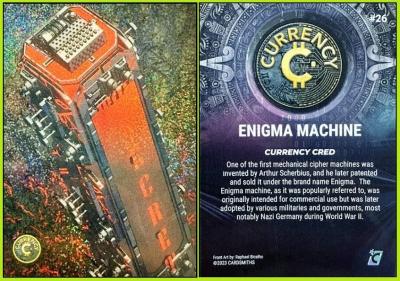
I was actually looking for the proper "Enigma" machine, but failed to find it on a card. Likewise, Bletchley Park does not appear to feature in any of the sets of country houses, though it was one, before it became the home of the Government Code and Cypher School in the Second World War. But this card does reference the original "Enigma" machine, and so got the nod.
The reason for this is that one of the first class stamps celebrates William Tutte, for "Codebreaking the Lorenz cipher machine at Bletchley Park". Now the Lorenz machines were not "Enigma"s, but they were used by the Germans, and made in that country by C. Lorenz AG, of Berlin. They were actually quite cunning, as they were devices which attached to a standard teleprinter, so you did not have to carry a machine, only this attachment. And more than that, if you found the attachment, without realising that it fitted to something else, it would have been impossible to make work. Because of this, the Germans felt safe at sending all their most important information by the codes they created, but once they were discovered, and the codes cracked, it gave immense power to the Allied forces.
If you would like to read the full story, head over to Wikipedia/Lorenz Cipher
As for Cardsmiths, they are a new name to me, and probably to you. but their website reveals that they already have an impressive stable of issues, over fifty of them, including many sets related to "pop culture" and entertainment.
They also enjoy producing short run and limited editions of their sets - this card, for example, is in "Crystal Sparkle" - but you can also find it in "iced foil", "rainbow holofoil", and a selection of what are known as "gemstone" cards.
Friday, 2nd May 2025
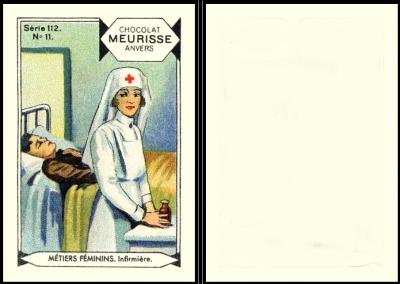
Here we have a nurse and that links to the first class stamp of Mary Morris, whose inscription says "Nursing at home and on the Front Line".
Her life was much more than that though. First of all, Morris was her husband`s name, she was born Mary Ellen Mulry in February 1921, in County Galway, Ireland. She left Ireland just before the start of the Second World War, aged eighteen, and came to England, where she worked at Guys Hospital. After she passed her exams, she was sent to Kent, and her first real job was to nurse the men who were coming back from Dunkirk. Kent was also the centre for the Battle of Britain, and she was involved with that too. However her passion seems to have been the care of children, and she trained as a fever nurse, something quite dangerous, as there was a very high risk of transmission from patient to nurse, and little knowledge of how to prevent it. It was in this capacity that she found herself transporting very sick children from their hospital beds down into the hopeful security of the nearest air raid shelter during the Blitz.
That was not all, for she wanted more, and enlisted with Queen Alexandra's Imperial Military Nursing Service Reserves, and was sent to Normandy, just twelve days after D-Day, to repair survivors and send the back to war. And she met her future husband there, though I do not know if he was one of her patients.
She also had a son, in 1947, but there the diary ends. All we know after that is that she died in about 1997, in Wales.
I have a partial checklist of these, which is :
- Dentelliere Flamande [lacemaker]
- Perleuse [beadmaker]
- Blanchisseuse [laundress]
- Modiste [milliner]
- Tissage en Tcheco-Slovaquie [weaving in Czechoslovakia]
- Corsetiere [corset maker]
- Tailleuse [female tailor]
- Brodeuse Suisse [Swiss embroiderer]
- Coiffeuse [hairdresser]
- Repasseuse [ironer]
- Infirmierie [nurse - or infirmary worker]
- Fileuse [spinner]
I have to say that most of these are rather uninspiring jobs, with little variation day to day, and even the ones that sound a bit more exciting, like the corset maker and the beadmaker, would not be so easy on the eyes, requiring a lot of close work and probably in not much light. Their eyes would not thank them, when they grew old.
And so time defeats me, once more. I am rather tired, it has been a very long day. But I hope to wake bright and early tomorrow and fill in the gaps.
Have a great weekend, and take time to rest.
And I will be back, next weekend, with another edition!
